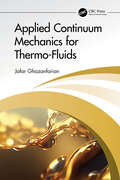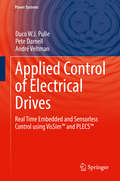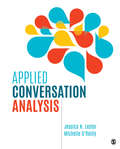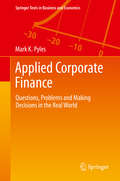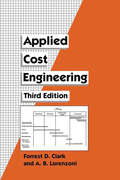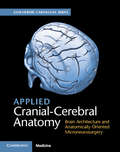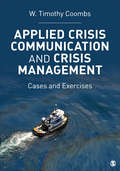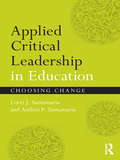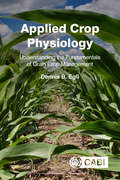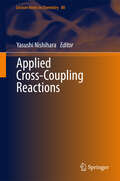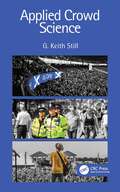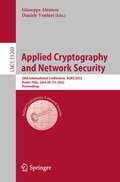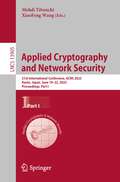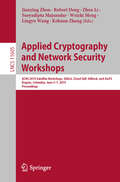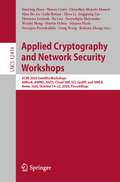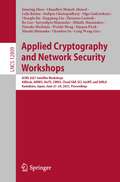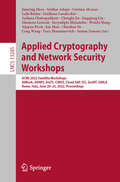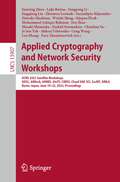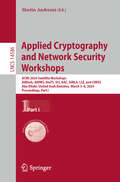- Table View
- List View
Applied Conic Finance
by Wim Schoutens Dilip MadanThis is a comprehensive introduction to the brand new theory of conic finance, also referred to as the two-price theory, which determines bid and ask prices in a consistent and fundamentally motivated manner. Whilst theories of one price classically eliminate all risk, the concept of acceptable risks is critical to the foundations of the two-price theory which sees risk elimination as typically unattainable in a modern financial economy. Practical examples and case studies provide the reader with a comprehensive introduction to the fundamentals of the theory, a variety of advanced quantitative models, and numerous real-world applications, including portfolio theory, option positioning, hedging, and trading contexts. This book offers a quantitative and practical approach for readers familiar with the basics of mathematical finance to allow them to boldly go where no quant has gone before.
Applied Conjoint Analysis
by Vithala R. RaoConjoint analysis is probably the most significant development in marketing research in the past few decades. It can be described as a set of techniques ideally suited to studying customers' decision-making processes and determining tradeoffs. Though this book is oriented towards methods and applications of conjoint analysis in marketing, conjoint methods are also applicable for other business and social sciences. After an introduction to the basic ideas of conjoint analysis the book describes the steps involved in designing a ratings-based conjoint study, it covers various methods for estimating partworth functions from preference ratings data, and dedicates a chapter on methods of design and analysis of conjoint-based choice experiments, where choice is measured directly. Chapter 5 describes several methods for handling a large number of attributes. Chapters 6 through 8 discuss the use of conjoint analysis for specific applications like product and service design or product line decisions, product positioning and market segmentation decisions, and pricing decisions. Chapter 9 collates miscellaneous applications of marketing mix including marketing resource allocation or store location decisions. Finally, Chapter 10 reviews more recent developments in experimental design and data analysis and presents an assessment of future developments.
Applied Continuum Mechanics for Thermo-Fluids
by Jafar GhazanfarianApplied Continuum Mechanics for Thermo-Fluids presents the tensor notation rules and integral theorems before defining the preliminary concepts and applications of continuum mechanics. It bridges the gap between physical concepts and mathematical expressions with a rigorous mathematical treatment. After discussing fundamental concepts of continuum mechanics, the text explains basic subjects such as the Stokes hypothesis, the second coefficient of viscosity, non-Newtonian fluids, non-symmetric stress tensor, and the full Navier-Stokes equation. With coverage of interdisciplinary topics, the book highlights issues such as relativistic fluid mechanics, stochastic mechanics, fractional calculus, nanoscale fluid mechanics, polar fluids, electrodynamics, and traffic flows. It describes fundamental concepts of vorticity dynamics, including the definition of vorticity and circulation, with corresponding balance equations and related theorems.This text is intended for upper-level undergraduate and postgraduate mechanical, chemical, aerospace, civil engineering, and physics students taking continuum mechanics, advanced fluid mechanics, convective heat transfer, turbulence, or any other similar courses. In addition, this book can be an excellent resource for scientists who want to initiate research on topics related to thermo-fluids.Instructors will be able to utilize a Solutions Manual and Figure Slides for their courses. The eBook+ version includes the following enhancements: Videos placed throughout the text containing further explanation of key topics Multiple-choice quizzes to reinforce readers' understanding of physical concepts
Applied Control Systems Design
by Magdi S. Mahmoud Yuanqing XiaApplied Control System Design examines several methods for building up systems models based on real experimental data from typical industrial processes and incorporating system identification techniques. The text takes a comparative approach to the models derived in this way judging their suitability for use in different systems and under different operational circumstances. A broad spectrum of control methods including various forms of filtering, feedback and feedforward control is applied to the models and the guidelines derived from the closed-loop responses are then composed into a concrete self-tested recipe to serve as a check-list for industrial engineers or control designers. System identification and control design are given equal weight in model derivation and testing to reflect their equality of importance in the proper design and optimization of high-performance control systems. Readers' assimilation of the material discussed is assisted by the provision of problems and examples. Most of these exercises use MATLAB® to make computation and visualization more straightforward. Applied Control System Design will be of interest to academic researchers for its comparison of different systems models and their response to different control methods and will assist graduate students in learning the practical necessities of advanced control system design. The consistent reference to real systems coupled with self-learning tools will assist control practitioners who wish to keep up to date with the latest control design ideas.
Applied Control of Electrical Drives: Real Time Embedded and Sensorless Control using VisSim™ and PLECS™ (Power Systems)
by Duco W. J. Pulle Pete Darnell André Veltman· Provides an overall understanding of all aspects of AC electrical drives, from the motor and converter to the implemented control algorithm, with minimum mathematics needed · Demonstrates how to implement and debug electrical drive systems using a set of dedicated hardware platforms, motor setup and software tools in VisSim(tm) and PLECS(tm) · No expert programming skills required, allowing the reader to concentrate on drive development · Enables the reader to undertake real-time control of a safe (low voltage) and low cost experimental drive This book puts the fundamental and advanced concepts behind electric drives into practice. Avoiding involved mathematics whenever practical, this book shows the reader how to implement a range of modern day electrical drive concepts, without requiring in depth programming skills. It allows the user to build and run a series of AC drive concepts, ranging from very basic drives to sophisticated sensorless drives. Hence the book is the only modern resource available that bridges the gap between simulation and the actual experimental environment. Engineers who need to implement an electrical drive, or transition from sensored to sensorless drives, as well as students who need to understand the practical aspects of working with electrical drives, will greatly benefit from this unique reference.
Applied Conversation Analysis
by Charles AntakiMuch of everyday work is done through talk between practitioner and client. Conversation Analysis is the close inspection of people's use of language in interaction. The work reported in this collection shows how CA can be used to identify, and improve, communicative practices at work.
Applied Conversation Analysis: Social Interaction in Institutional Settings
by Jessica Nina Lester Michelle O′ReillyFocusing on applied conversation analysis (CA), this timely book offers practical insights and guidelines for CA scholars studying social interactions in institutional settings. Written in an accessible style and packed with case studies, examples, activities, and practical tips, the book takes readers through the entire process of planning and carrying out an applied CA research study. By highlighting challenges, debates, and important questions, each chapter provides the theoretical foundation necessary for making informed decisions at every stage of a research project. The book is divided into three sections (context and planning, doing a project using conversation analysis, and disseminating your research) to mirror the research process.<br
Applied Conversation Analysis: Social Interaction in Institutional Settings
by Jessica Nina Lester Michelle O′ReillyFocusing on applied conversation analysis (CA), this timely book offers practical insights and guidelines for CA scholars studying social interactions in institutional settings. Written in an accessible style and packed with case studies, examples, activities, and practical tips, the book takes readers through the entire process of planning and carrying out an applied CA research study. By highlighting challenges, debates, and important questions, each chapter provides the theoretical foundation necessary for making informed decisions at every stage of a research project. The book is divided into three sections (context and planning, doing a project using conversation analysis, and disseminating your research) to mirror the research process.<br
Applied Corporate Finance: Making Value-Enhancing Decisions in the Real World (Springer Texts in Business and Economics)
by Mark K. PylesThis textbook helps students truly understand how to apply the principles behind corporate finance in a real world context from both a firm and investor perspective. In its second edition, this text focuses on traditional theory applied to a holistic and realistic business case study, written as a novel set in current times so that all readers can relate. As such, this textbook offers readers both a quantitative and qualitative perspective on topics such as capital budgeting, time value of money, corporate risk, and capital structure. The sections are laid out to mirror the financial decision process, making it easier for readers to grasp the idea of the corporate financial life cycle. New topics such as socially responsible investing and private capital markets are also incorporated into this edition. Finally, PowerPoint slides, answer keys and data sets are available online for instructors.
Applied Corporate Finance: Questions, Problems and Making Decisions in the Real World (Springer Texts in Business and Economics)
by Mark K. PylesApplied Corporate Finance fills a gap in the existing resources available to students and professionals needing an academically rigorous, yet practically orientated, source of knowledge about corporate finance. Written by an expert in investment analysis, this textbook leads readers to truly understand the principles behind corporate finance in a real world context from both a firm and investor perspective. The focus of this text is on traditional theory applied to a holistic business case study, offering readers both a quantitative and qualitative perspective on such topics as capital budgeting, time value of money, corporate risk, and capital structure. Each section in the book corresponds to the order in which a business makes key financial decisions--as opposed to level of difficulty--allowing readers to grasp a comprehensive understanding of the corporate financial life cycle. Directly addressing the area of corporate finance in an applied setting, and featuring numerous case examples and end-of-chapter discussion questions and problems, this textbook will appeal to advanced undergraduates majoring in finance, graduate-level students, as well as professionals in need of a quick refresher on corporate financial policy.
Applied Cost Engineering (Cost Engineering)
by Forrest Clark A.B. LorenzoniThis thoroughly rewritten and updated third edition offers comprehensive coverage of cost engineering, emphasizing capital projects and focusing on both estimating and cost control. Maintaining and enhancing the style of presentation that made the previous editions so popular, Applied Cost Engineering, Third Edition furnishes an entirely new and cost-effective approach to estimating and controlling contingency, a new chapter on systems and computer applications, a new chapter on bulk material control, expanded coverage of the factors that affect estimate accuracy, an introduction to the concept of estimate and schedule classification, additional end-of-text case studies, and much more.
Applied Cranial-Cerebral Anatomy: Brain Architecture and Anatomically Oriented Microneurosurgery
by Guilherme Carvalhal RibasThis book is the first to offer a comprehensive guide to understanding the brain's architecture from a topographical viewpoint. <P><P>Authored by a leading expert in surgical neuroanatomy, this practical text provides tri-dimensional understanding of the cerebral hemispheres, and the relationships between cerebral surfaces and the skull's outer surfaces through detailed brain dissections and actual clinical cases with operative photographs and correlative neuroimaging. For neurosurgeons, neuroradiologists and neurologists at all levels, this book emphasises the anatomy of the sulci and gyri of the cerebral surface. It is an essential resource for the general neurosurgery practice, and more particularly for planning surgical access routes for intracranial tumors. Authored by an international leading authority on macroscopic neuroanatomy, written from the author's extensive clinical experience. Heavily illustrated with operative photographs and correlative neuroimaging, for a detailed topographical understanding of intracranial neural structures. Focuses on resective surgery planning, for non-oncologic disease treatment
Applied Crisis Communication and Crisis Management: Cases and Exercises
by Timothy CoombsDesigned to give students and public relations professionals the knowledge and skills they need to become successful crisis managers, this practical book includes a wide range of cases that explore crisis communication and management in action. In the first two chapters, the author introduces key theories and principles in crisis communication, which students apply by analyzing 17 cases drawn from recent headlines. Cases are explored from pre-crisis, mid-crisis, and post-crisis communication perspectives, and include a range of predominant crisis scenarios from product recalls to lawsuits to environmental disasters
Applied Critical Leadership in Education: Choosing Change
by Lorri J. Santamaría Andrés P. SantamaríaEducational leaders are seeing the increasing need for practical transformative models and theories to address academic, cultural, and socio-economic gaps separating learners at all levels of the educational system. Applied Critical Leadership in Education explores a leadership model arising from critical theory and critical pedagogy traditions that transforms status quo educational practices. Providing a range of diverse voices of practicing leaders from prekindergarten through higher education, explicit ties to theory and practice are drawn, making leadership for social justice accessible, feasible, and more practical for aspiring and practicing leaders alike. Features Included: Case Studies provide examples of applied critical leadership across early childhood education, elementary school, middle school, high school, district, and higher education levels. Theory to Research Applications offer frameworks and key research complementary to cases. Checking In presents questions to the reader to respond and further engage with the chapter content. Opportunity Recognition and Critical Conversations offer strategies to challenge assumptions of common practices and begin conversations around issues of social justice. Backpack includes online or print resources to supplement the material in each chapter. Appendix provides a comprehensive example of qualitative case study research from design, to data collection, and analysis. Applied Critical Leadership in Education provides an innovative way for aspiring and practicing educational leaders to think about and apply leadership practice suited for the educational challenges of today that are necessary for change.
Applied Crop Physiology: Understanding the Fundamentals of Grain Crop Management
by Dennis EgliThis book presents a simple, straightforward discussion of the principles and processes involved in the production of grain yield by agronomic crops, and how these processes underlie and influence management decisions. The focus is on grain crops, principally maize and soybean, although the general principles apply equally well to cereals, grain legumes and oil crops. Management decisions define all cropping systems - what (crop species, variety), where (climate), when (planting date), and how (row spacing and population density) are the fundamental choices. Knowledge of the fundamental processes responsible for plant growth and the accumulation of yield simplifies the decision-making process and leads to improved management decisions, higher grain yields, and cropping systems that are efficient, resilient and sustainable. The contents include: · Basic plant growth processes e.g. photosynthesis, respiration, evapotranspiration · Growth and production of yield · Crop management - seed quality, variety selection, plant date, row spacing · Crop production in the future - climate change, GMOs, precision data and new crops Intended for researchers in crop science, agronomy and plant science, and crop production practitioners, this book will enable readers to make better, more informed management decisions; decisions that will help maintain a well-fed world in the future.
Applied Cross-Coupling Reactions (Lecture Notes in Chemistry #80)
by Yasushi Nishihara"Applied Cross-Coupling Reactions" provides students and teachers of advanced organic chemistry with an overview of the history, mechanisms and applications of cross-coupling reactions. Since the discovery of the transition-metal-catalyzed cross-coupling reactions in 1972, numerous synthetic uses and industrial applications have been developed. The mechanistic studies of the cross-coupling reactions have disclosed that three fundamental reactions: oxidative addition, transmetalation, and reductive elimination, are involved in a catalytic cycle. Cross-coupling reactions have allowed us to produce a variety of compounds for industrial purposes, such as natural products, pharmaceuticals, liquid crystals and conjugate polymers for use in electronic devices. Indeed, the Nobel Prize for Chemistry in 2010 was awarded for work on cross-coupling reactions. In this book, the recent trends in cross-coupling reactions are also introduced from the point of view of synthesis design and catalytic activities of transition-metal catalysts.
Applied Crowd Science
by G. Keith StillApplied Crowd Science outlines the theory and applications of the crowd safety course that Prof. Keith Still has developed and taught worldwide for over thirty years. It includes the background and applications of the crowd risk assessment tools, as well as essays and case studies from international users (UK, Ireland, Canada, Australia, Holland, Belgium and Japan). Keith’s courses are mandatory training for all UK Police Public Event Commanders. The text covers legislation and guidance for crowd safety in places of public assembly, and outlines the requirements of a crowd risk assessment for mass gatherings. It draws on Prof. Still’s expert witness experience, highlighting both the problems you need to understand for your event planning.
Applied Cryptography and Network Security: 20th International Conference, ACNS 2022, Rome, Italy, June 20–23, 2022, Proceedings (Lecture Notes in Computer Science #13269)
by Giuseppe Ateniese Daniele VenturiThe LNCS volume 13269 constitutes the proceedings of the 20th International Conference on Applied Cryptography and Network Security, ACNS 2022, which will take place in a hybrid mode in Rome, Italy in June 2022. The 44 full papers together with 5 short papers presented in this proceeding were carefully reviewed and selected from a total of 174 submissions. They were organized in topical sections as follows: Encryption, Attacks, Cryptographic Protocols, System Security., Cryptographic Primitives, MPC, Blockchain, Block-Cyphers, and Post-Quantum Cryptography.
Applied Cryptography and Network Security: 21st International Conference, ACNS 2023, Kyoto, Japan, June 19–22, 2023, Proceedings, Part I (Lecture Notes in Computer Science #13905)
by XiaoFeng Wang Mehdi TibouchiThe LNCS two-volume set 13905 and LNCS 13906 constitutes the refereed proceedings of the 21st International Conference on Applied Cryptography and Network Security, ACNS 2023, held in Tokyo, Japan, during June 19-22, 2023. The 53 full papers included in these proceedings were carefully reviewed and selected from a total of 263 submissions. They are organized in topical sections as follows: Part I: side-channel and fault attacks; symmetric cryptanalysis; web security; elliptic curves and pairings; homomorphic cryptography; machine learning; and lattices and codes. Part II: embedded security; privacy-preserving protocols; isogeny-based cryptography; encryption; advanced primitives; multiparty computation; and Blockchain.
Applied Cryptography and Network Security Workshops: ACNS 2019 Satellite Workshops, SiMLA, Cloud S&P, AIBlock, and AIoTS, Bogota, Colombia, June 5–7, 2019, Proceedings (Lecture Notes in Computer Science #11605)
by Lingyu Wang Jianying Zhou Zhou Li Robert Deng Weizhi Meng Suryadipta Majumdar Kehuan ZhangThis book constitutes the proceedings of the satellite workshops held around the 17th International Conference on Applied Cryptography and Network Security, ACNS 2019, in Bogota, Colombia, in June 2019. The 10 papers presented in this volume were carefully reviewed and selected from 30 submissions. They stem from the following workshops:AIBlock 2019: First International Workshop on Application Intelligence and Blockchain SecurityAIoTS 2019:First International Workshop on Articial Intelligence and Industrial Internet-of-Things SecurityCloud S&P 2019:First International Workshop on Cloud Security and PrivacyPriDA 2019:First InternationalWorkshop on Privacy-preserving Distributed Data AnalysisSiMLA 2019: First International Workshop on Security in Machine Learning and its Applications
Applied Cryptography and Network Security Workshops: ACNS 2020 Satellite Workshops, AIBlock, AIHWS, AIoTS, Cloud S&P, SCI, SecMT, and SiMLA, Rome, Italy, October 19–22, 2020, Proceedings (Lecture Notes in Computer Science #12418)
by Cong Wang Mauro Conti Jianying Zhou Zhou Li Man Ho Au Weizhi Meng Martín Ochoa Suryadipta Majumdar Kehuan Zhang Georgios Portokalidis Lejla Batina Chuadhry Mujeeb Ahmed Jingqiang Lin Eleonora Losiouk Bo Luo Stjepan PicekThis book constitutes the proceedings of the satellite workshops held around the 18th International Conference on Applied Cryptography and Network Security, ACNS 2020, in Rome, Italy, in October 2020. The 31 papers presented in this volume were carefully reviewed and selected from 65 submissions. They stem from the following workshops: AIBlock 2020:Second International Workshop on Application Intelligence and Blockchain Security AIHWS 2020:First International Workshop on Artificial Intelligence in Hardware Security AIoTS 2020:Second International Workshop on Artificial Intelligence and Industrial Internet-of-Things Security Cloud S&P 2020:Second International Workshop on Cloud Security and Privacy SCI 2020:First International Workshop on Secure Cryptographic Implementation SecMT 2020:First International Workshop on Security in Mobile Technologies SiMLA 2020: Second International Workshop on Security in Machine Learning and its Applications
Applied Cryptography and Network Security Workshops: ACNS 2021 Satellite Workshops, AIBlock, AIHWS, AIoTS, CIMSS, Cloud S&P, SCI, SecMT, and SiMLA, Kamakura, Japan, June 21–24, 2021, Proceedings (Lecture Notes in Computer Science #12809)
by Cong Wang Jianying Zhou Chunhua Su Weizhi Meng Suryadipta Majumdar Lejla Batina Chuadhry Mujeeb Ahmed Jingqiang Lin Eleonora Losiouk Bo Luo Stjepan Picek Olga Gadyatskaya Sudipta Chattopadhyay Chenglu Jin Mihalis Maniatakos Daisuke Mashima Masaki ShimaokaThis book constitutes the proceedings of the satellite workshops held around the 19th International Conference on Applied Cryptography and Network Security, ACNS 2021, held in Kamakura, Japan, in June 2021.The 26 papers presented in this volume were carefully reviewed and selected from 49 submissions. They stem from the following workshops: AIBlock 2021: Third International Workshop on Application Intelligence and Blockchain Security AIHWS 2021: Second International Workshop on Artificial Intelligence in Hardware Security AIoTS 2021: Third International Workshop on Artificial Intelligence and Industrial IoT Security CIMSS 2021: First International Workshop on Critical Infrastructure and Manufacturing System Security Cloud S&P 2021: Third International Workshop on Cloud Security and Privacy SCI 2021: Second International Workshop on Secure Cryptographic Implementation SecMT 2021: Second International Workshop on Security in Mobile Technologies SiMLA 2021; Third International Workshop on Security in Machine Learning and its ApplicationsDue to the Corona pandemic the workshop was held as a virtual event.
Applied Cryptography and Network Security Workshops: ACNS 2022 Satellite Workshops, AIBlock, AIHWS, AIoTS, CIMSS, Cloud S&P, SCI, SecMT, SiMLA, Rome, Italy, June 20–23, 2022, Proceedings (Lecture Notes in Computer Science #13285)
by Cong Wang Jianying Zhou Chunhua Su Cristina Alcaraz Emiliano Casalicchio Weizhi Meng Jun Shao Suryadipta Majumdar Lejla Batina Jingqiang Lin Eleonora Losiouk Stjepan Picek Sudipta Chattopadhyay Chenglu Jin Sridhar Adepu Yury Zhauniarovich Saman ZonouzThis book constitutes the proceedings of the satellite workshops held around the 20th International Conference on Applied Cryptography and Network Security, ACNS 2022, held in Rome, Italy, in June 2022. Due to the Corona pandemic the workshop was held as a virtual event. The 31 papers presented in this volume were carefully reviewed and selected from 52 submissions. They stem from the following workshops:– AIBlock: 4th ACNS Workshop on Application Intelligence and Blockchain Security– AIHWS: 3rd ACNS Workshop on Artificial Intelligence in Hardware Security– AIoTS: 4th ACNS Workshop on Artificial Intelligence and Industrial IoT Security– CIMSS: 2nd ACNS Workshop on Critical Infrastructure and Manufacturing System Security– Cloud S&P: 4th ACNS Workshop on Cloud Security and Privacy– SCI: 3rd ACNS Workshop on Secure Cryptographic Implementation– SecMT: 3rd ACNS Workshop on Security in Mobile Technologies– SiMLA: 4th ACNS Workshop on Security in Machine Learning and its Applications
Applied Cryptography and Network Security Workshops: ACNS 2023 Satellite Workshops, ADSC, AIBlock, AIHWS, AIoTS, CIMSS, Cloud S&P, SCI, SecMT, SiMLA, Kyoto, Japan, June 19–22, 2023, Proceedings (Lecture Notes in Computer Science #13907)
by Cong Wang Mohammad Ashiqur Rahman Jianying Zhou Chunhua Su Weizhi Meng Jun Shao Suryadipta Majumdar Lejla Batina Leo Zhang Jingqiang Lin Eleonora Losiouk Stjepan Picek Daisuke Mashima Masaki Shimaoka Yury Zhauniarovich Zengpeng Li Ezekiel Soremekun Je Sen Teh Aleksei UdovenkoThis book constitutes the proceedings of the satellite workshops held around the 21st International Conference on Applied Cryptography and Network Security, ACNS 2023, held in Kyoto, Japan, in June 2023.The 34 full papers and 13 poster papers presented in this volume were carefully reviewed and selected from 76 submissions. They stem from the following workshops: · 1st ACNS Workshop on Automated Methods and Data-driven Techniques in Symmetric-key Cryptanalysis (ADSC 2023) · 5th ACNS Workshop on Application Intelligence and Blockchain Security (AIBlock 2023) · 4th ACNS Workshop on Artificial Intelligence in Hardware Security (AIHWS 2023) · 5th ACNS Workshop on Artificial Intelligence and Industrial IoT Security (AIoTS 2023) · 3rd ACNS Workshop on Critical Infrastructure and Manufacturing System Security (CIMSS 2023) · 5th ACNS Workshop on Cloud Security and Privacy (Cloud S&P 2023) · 4th ACNS Workshop on Secure Cryptographic Implementation (SCI 2023) · 4th ACNS Workshop on Security in Mobile Technologies (SecMT 2023) · 5th ACNS Workshop on Security in Machine Learning and its Applications (SiMLA 2023)
Applied Cryptography and Network Security Workshops: ACNS 2024 Satellite Workshops, AIBlock, AIHWS, AIoTS, SCI, AAC, SiMLA, LLE, and CIMSS, Abu Dhabi, United Arab Emirates, March 5–8, 2024, Proceedings, Part I (Lecture Notes in Computer Science #14586)
by Martin AndreoniThis two-volume set LNCS 14586-14587 constitutes the proceedings of eight Satellite Workshops held in parallel with the 22nd International Conference on Applied Cryptography and Network Security, ACNS 2024, held in Abhu Dabhi, United Arab Emirates, during March 5-8, 2024. The 33 full papers and 11 poster papers presented in this volume were carefully reviewed and selected from 62 submissions. They stem from the following workshops: 6th ACNS Workshop on Application Intelligence and Blockchain Security (AIBlock 2024). 5th ACNS Workshop on Artificial Intelligence in Hardware Security (AIHWS 2024). 6th ACNS Workshop on Artificial Intelligence and Industrial IoT Security (AIoTS 2024). 5th ACNS Workshop on Secure Cryptographic Implementation (SCI 2024). 1st Workshop on Advances in Asymmetric Cryptanalysis (AAC 2024). 6th ACNS Workshop on Security in Machine Learning and its Applications (SiMLA 2024). 1st Workshop on Low-Latency Encryption (LLE 2024). 4th ACNS Workshop on Critical Infrastructure and Manufacturing System Security (CIMSS 2024).


